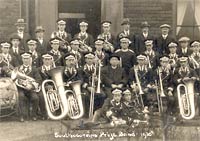Musical Associations of Calderdale

Calderdale has a long established musical tradition which has emerged in a variety of forms over the years - in choral music, orchestras, religious gatherings, brass bands and amateur operatic societies.
The Halifax Choral Society, established in 1817, is the oldest surviving society of its kind in the country, although the Huddersfield Choral has become more prominent due to its media appearances. Halifax Choral Society and its rendition of Handel's 'Messiah' has become an annual feature in the local calendar.
Other societies abound, including the Halifax Male Voice Choir, which dates from 1931 and in earlier days was a regular and successful entrant in festivals and competitions, the Halifax Madrigal Society and innumerable lesser-known ones connected with local schools, churches and Sunday schools. Singing is a form of expression which appeals strongly to the inhabitants of these rugged Pennine hills and is an enjoyable way of giving vent to emotions which otherwise would in many cases remain hidden. Much of this love of singing has its roots in the local nonconformist background and the choirs of little hillside chapels have been a training ground for many a local singer.
The Halifax Orchestral Society was formed in 1833 and carried on until 1850. In the following year it was succeeded by the Halifax Philharmonic Society which lasted until 1880. The Northgate-End Orchestral Society was formed in 1882 and carried on until 1908 when the name reverted to the Halifax Orchestral Society. In more recent times school orchestras have been formed, culminating in the Calderdale Youth Orchestra which has proved extremely successful providing training for many aspiring musicians.
A prominent event for many years was the 'Halifax Sing' which, from 1831 to 1890, was held every five years in the Halifax Piece Hall. This was a gathering of scholars from the Sunday schools throughout Calderdale when they converged on Halifax and took their allotted places in the great courtyard prepared to sing all day with gusto the carefully rehearsed hymns they had been taught. Regaled with light refreshments in the intervals they all appear to have enjoyed their day out and the memory of it was long to remain.
Brass bands have always been popular in Calderdale among the musicians who have taken part and also with their many devotees. The brass band seems to be to some extent a phenomenon of northern England where it has long been accepted as a way of learning music and to enjoy playing a wind instrument in the company of friends. This interest in brass bands and the music they play has led to the formation of several local bands which have become famous. The Black Dyke Band is particularly well-known, as too is the Brighouse and Rastrick Band, whose rendering of 'The Floral Dance' topped the charts some years ago. The Elland Silver Band has its following also, and in many districts of Calderdale there is a brass band, some not as well-known, but all enjoying meeting together to produce the music they love. The Lee Mount Brass Band, which when it was first formed in 1888 rehearsed in a greenhouse, came back from a competition at the Crystal Palace in 1901 bearing the coveted thousand guineas gold championship trophy. Sadly, the coming of World War 2 spelt the end of the band c.1940. In many cases bands have been backed by the firms where the musicians were employed and local people, both musicians and their audiences owe a debt of gratitude to these philanthropic employers.
Amateur operatic societies abound in Calderdale where the tradition of Gilbert and Sullivan operettas is enthusiastically carried on and where the music of Strauss, Romberg and modern composers of light operas and musicals such as Rogers and Hart, and Lloyd Webber is never silent. In church halls, theatres and rehearsal rooms societies prepare to give of their best for a few evenings when they enjoy a brief hour of fame, and their audiences are quick to assert that it was worth turning out for despite the cold of the winter's night.
Susan Sunderland (baptised Susannah Sykes), the famous Victorian soprano, was born in Brighouse and lived there all her life. She was known as the "Yorkshire Queen of Song" after singing before Queen Victoria in Buckingham Palace. Money raised from her Golden wedding concert at Brighouse Town Hall in 1888, funded the first Mrs Sunderland Music Festival, still held annually in Huddersfield Town Hall.
Sir George Dyson (1883-1964) was a son of Halifax who rose to fame as a composer and conductor, chiefly with his choral piece 'The Canterbury Pilgrims' (1931)
The great tenor Walter Widdop (1892-1949) was also born in Calderdale, at Norland, and as a famous singer brought great credit to his home town. He began working in a dyehouse and sang in Norland Church choir before realising his potential as a singer and he became a leading Wagnerian tenor.
Themes
- Calderdale architecture
- Canals in Calderdale
- Chartism
- Colonel Edward Akroyd
- Crossley and Porter School
- Crossley family
- Factory conditions
- Famous people of Calderdale
- The manorial fulling mill
- Growth of education in Calderdale
- Halifax cinemas
- Halifax Moot Hall
- Halifax Theatres
- Hudsonites
- John Fielden
- John Mackintosh
- Military associations with Calderdale
- Musical associations of Calderdale
- Piece Hall
- Plug riots
- Poor law
- Railways in Calderdale
- Role and influence of women in Calderdale
- Social welfare
- Turnpike Roads in Calderdale
- Wainhouse Tower
- World War One
- Yorkshire Coiners


